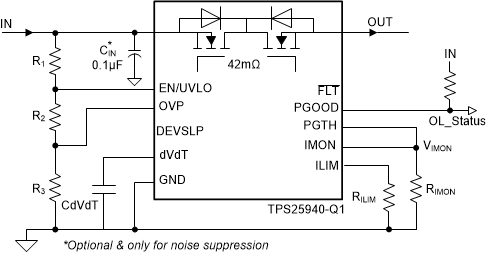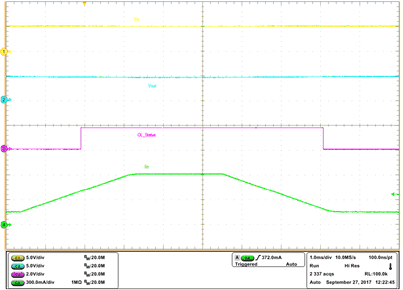ZHCSF29E May 2016 – January 2021 TPS25940-Q1
PRODMIX
- 1 特性
- 2 应用
- 3 说明
- 4 Revision History
- 5 Device Comparison Table
- 6 Pin Configuration and Functions
- 7 Specifications
- 8 Parametric Measurement Information
-
9 Detailed Description
- 9.1 Overview
- 9.2 Functional Block Diagram
- 9.3 Feature Description
- 9.4 Device Functional Modes
-
10Application and Implementation
- 10.1 Application Information
- 10.2
Typical Application
- 10.2.1 Design Requirements
- 10.2.2
Detailed Design Procedure
- 10.2.2.1 Step by Step Design Procedure
- 10.2.2.2 Programming the Current-Limit Threshold: R(ILIM) Selection
- 10.2.2.3 Undervoltage Lockout and Overvoltage Set Point
- 10.2.2.4 Programming Current Monitoring Resistor—RIMON
- 10.2.2.5 Setting Output Voltage Ramp Time (tdVdT)
- 10.2.2.6 Programing the Power Good Set Point
- 10.2.2.7 Support Component Selections—R6, R7 and CIN
- 10.2.3 Application Curves
- 10.2.4 System Examples
- 11Power Supply Recommendations
- 12Layout
- 13Device and Documentation Support
- 14Mechanical, Packaging, and Orderable Information
10.2.4.3 Overload Detection Using TPS25940xx-Q1
The TPS25940xx-Q1 device has enhanced features such as load current monitoring output IMON and an integrated power good comparator for voltage monitoring. These two functional blocks can be utilized as per circuit configuration shown in Figure 10-27, to FLAG the overload event.
 Figure 10-27 Circuit Configuration for Overload Detection Using TPS25940xx-Q1
Figure 10-27 Circuit Configuration for Overload Detection Using TPS25940xx-Q1The output voltage at IMON terminal VIMON can be used as a means of monitoring current flow through the system and its value can be calculated from Equation 6.
The power good comparator of TPS25940xx-Q1 has an internal reference of VPGTHR = 0.99 V at the negative terminal and the positive terminal PGTH can be utilized for monitoring voltage of any specific rail. As shown in the Figure 10-27, the output voltage at IMON terminal (VIMON) is fed to the positive terminal PGTH (VPGTH) of the comparator. When the PGTH pin voltage (VPGTH = VIMON) is higher than the internal reference VPGTHR, the open-drain comparator output PGOOD asserts HIGH to indicate overload event.
For example, to detect overcurrent event at load current IOUT of 300 mA, the value of RIMON can be calculated using Equation 35.


A close value of 61.9 kΩ is chosen for RIMON.
Figure 10-28 shows the overload flag status when the load is changed from 150 mA to 600 mA and back. As seen in the Figure 10-28, the overload status (OL_Status) becomes active HIGH when the load current crosses 300 mA.
 Figure 10-28 Overload Flag Status for Change in Load from 150 mA to 600 mA and Back
Figure 10-28 Overload Flag Status for Change in Load from 150 mA to 600 mA and Back